

Get Your Musical Foundation In Place Now!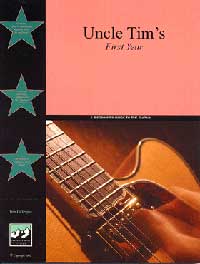
If you are struggling to know what chords are in what key or how the basic scale works within a key, you might be struggling when just a little information might make a HUGE difference.
You don't have to become a rules freak, but taking a little time to understand how a key works can take away ALL of that FRUSTRATION! And this is done visually so you do not need to read volumes to get it, just one thin book (88 pages).
Not knowing can stop your music right now and only understanding can make up for it. For $15, you can put this all to rest right now. Pick up a copy today.
eBooks are delivered instantly!
By Tim Gillespie
It is common to see beginner guitarists play scales yet have trouble turning a scale run into a lead. It is also common to see guitarists dismiss scales because they do not understand what scales do for them. Often times when a guitarist starts to play scales, it is not at all clear how to proceed and what to expect. Scales are a tool that must be used extensively to yield top level results. One of the tricks is to become so familiar with scales that playing them becomes second nature. Once this intimate level of control is obtained, scales will yield results far beyond what you might think when you start to use them.
So the more control you have over scales, the more control you will have when trying to shape a lead. Control almost always results in a better lead. Even in an improvisation. Decisions concerning routes and pathways usually occur very fast. There is not much time to contemplate which pathway is best. Particularly when mixing up the ordering of notes in an effort to be creative. Having a good physical understanding of scales will allow a person to choose from a greater palate of options and pick and play the choices with no hesitation. Practice is what allows this skill to take shape. This skill will develop over the course of a few years. No matter the level of control obtained in the first year, it will not compare to what the passage of time and steady practice will yield. The control you can get from steady practice will amaze you.
There is one other very big difference between scales and creating a lead. When you play scales you almost always play them by yourself. When you play lead guitar, you almost always do it with other people. All by themselves scale notes can sound puny and isolated. When played against other instruments they can take on a whole new meaning. The tones you generate will be in the framework of a key as will the other instruments. This can ignite your single note lines. Single note lines can easily control the direction of a piece of music. It provides the sense of motion and accents. But the notes you use to form a lead will be in harmony with other music that together forms the basis of the song. No matter what key you choose, you will certainly play together in some sort of framework.
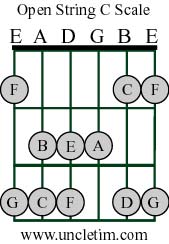



Here is an example of how chords and a scale are all related. The chords above are all carved out of the scale of C major. The first example is the scale of C major. Look, this music has to be related because it all comes out of the same key. They all adhere to the same rules and all relate to C. So if you play a modified C scale with these chords, you will probably create a line that strongly relates to the chords. It's natural that this happens.
So scales and chords (of the same key) are designed to work together.
There are a few other considerations that play a part in turning a scale into a lead. Before we look at breaking up a scale, we should talk a little about this. Keep in mind this is an overview. There will ultimately be many more influences that shape a lead but many are nuances.
1. Timing. Much of the intricacies of playing leads is having the right notes at the right time. A good sense of timing is important to playing the notes against the background of notes flowing from other instruments. Timing comes into play with the very first note of the song. The introduction of a melodic line can determine the direction of the music. At first pick songs to construct leads over that are somewhat slow. Trying to develop this skill with blistering fast songs and passages is not the way to go. If you keep the issues of timing simple, you have one less thing to worry about.
2. White space. This is a term I use to describe the quiet seconds, or fractions of seconds, between notes or phrases. Lead lines that contain hundreds of notes with no spaces between passages tend to run together. The notes seem to compress into a continuous stream with no beginning, no ending and muted personality. Inserting quiet moments into a solo can affect the timing in a positive way and accentuate the notes before and after the quiet space. The breaks in a solo can be quite short or long. This also gives you a micro second to reposition your hand if necessary.
3. Use the different areas of the fretboard. Know your options. For simplicity sake we can break the fretboard into three parts. The low area close to the nut, the middle of the fretboard between the third and tenth frets and the higher reaches of the fretboard. Often times a person does not know they have the entire fretboard at their disposal. Every scale in every key will be available for every part of the fretboard. With all this real estate available on the fretboard, there is bound to be some fertile ground for a solo over almost any piece of music.
Sometimes it is advantageous to move around the fretboard and see what sounds better against different parts of the rhythm section. Particularly when you have time to construct the solo and practice some ideas before performing it. You can use the open strings to play hammer ons and pull offs. You can mix chords and let the open strings ring. You can start low in a solo and gradually travel higher in the registers to build interest. You can play high notes against low chordings to add contrast. Lead guitarists have to constantly anticipate the direction of the song and add balance by carefully adding notes without overplaying.
In the beginning make sure you experiment without reservation. You have to travel and sample the different areas of the fretboard so you can get an understanding of the different sounds available. Take some time and run around a little.
4. Phrasing. There are a lot of elements that go into a lead line. This is the single biggest element there is in lead line creation. And often times this is where changing a scale into a lead line falls apart. Phrasing is the art of changing a static scale into a colorful lead line. Phrasing can be compared to talking. Try to notice this throughout the day. When you talk and enter into an exciting conversation, your voice rises and falls throughout the conversation. It does not climb steadily note after note and then descend. Instead most of us experience a rising and falling of our voices. This reflects our level of interest and conveys to the listener much of our feelings and excitement. It is much more interesting than a monotone voice.
However when we learn to play a lead line we start with scales. And that means we usually play scales by starting on the lowest note and climbing to the highest note and then back down. Sometimes we start high, work to the lower registers and then climb back up. Not so with a lead line. So there must be a conscious effort to turn a static tool into a interesting statement. Here is how you jump start the process.

This is the simple C major or A minor scale expressed using tablature. The horizontal lines are the physical strings and the circles show you behind which fret you should press the string down. This is the same scale as the one shown below which is in my usual way.
 As I have said before, this is the palate. We are going
to use the notes found here to carve out a lead line. Once you mix up
the notes you inject taste into this equation. Not everyone will agree
with your selection and you should not be critical at all when you start.
Your mission is to find notes you like and that interest you. But do not
be complacent. Mix things up often. Try different combinations and moves.
Travel to different areas of the fretboard.
As I have said before, this is the palate. We are going
to use the notes found here to carve out a lead line. Once you mix up
the notes you inject taste into this equation. Not everyone will agree
with your selection and you should not be critical at all when you start.
Your mission is to find notes you like and that interest you. But do not
be complacent. Mix things up often. Try different combinations and moves.
Travel to different areas of the fretboard.
It is the process of experimenting that will show you what you like. At first this process will seem awkward. My advise is to try new moves in slow motion. Your hands will not be accustomed to mixing up the sequence, so slowing down the process will allow for creative choices and precise execution. Your fretboard hand will experience minute changes in position because the different sequences of notes will require slight adjustments. This will become automatic with time if you play scales. But this must be developed before any results will show up. So experiment!

Now notice this piece of tablature. These are the same notes
as the scale above except for the ![]() .
The
.
The ![]() represents the A note on
the high E string and the C note on the G string. In this example we are
mixing up the sequence of notes to provide some interest. This phrase
can be played slowly or fast. It can be played with hammer ons or just
by hitting the notes straight up. Notice we jump from the lowest string
to the highest. Also notice there are small gaps where no notes are played.
I put these in to give you some time to think and move to a new position.
The D string is completely ignored in this run. This example illustrates
some of the combinations available. There are a thousands more iterations
just in this combination of notes under study.
represents the A note on
the high E string and the C note on the G string. In this example we are
mixing up the sequence of notes to provide some interest. This phrase
can be played slowly or fast. It can be played with hammer ons or just
by hitting the notes straight up. Notice we jump from the lowest string
to the highest. Also notice there are small gaps where no notes are played.
I put these in to give you some time to think and move to a new position.
The D string is completely ignored in this run. This example illustrates
some of the combinations available. There are a thousands more iterations
just in this combination of notes under study.
Try to play this. The results you get will depend on how comfortable you are playing single note lines. If you have been playing scales for a few months, you may be able to do this easily. Playing single note lines is much easier if you play scales. However sometimes when I play them, they don't sound inspired. They sound canned. The accent you place on certain notes and the level of smoothness you use will affect the final sound. So you may have to play them for a few days to get the feel and become comfortable.
Now lets concentrate on just a few strings to show some easy passages. This is a small study of the high E string.
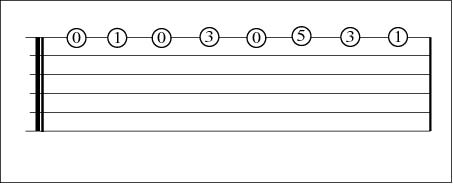 This example illustrates that you do not have to use a lot
of notes or cover a lot of ground. In fact concentrating on just a small
section can help you to pull out interesting combinations in a limited
space.
This example illustrates that you do not have to use a lot
of notes or cover a lot of ground. In fact concentrating on just a small
section can help you to pull out interesting combinations in a limited
space.
Notice this run starts on the E note (the third degree in the key of C) and ends on the C note (tonic). There is a built in reason to end runs on tonic. It brings the phrase to rest. Anyone who has played scales and has stopped on tonic knows how it brings the run to rest. You can always start up again but resting on tonic is common and makes a lot of sense.
Also notice that we are being playful on the high E string. We are combining the notes in a way you would never play if you were just playing scales. The open E note is used three times as we climb to higher notes. There are only four different notes used on the E string but we are playing nine notes. This example should show you that it does not take much room to be creative.
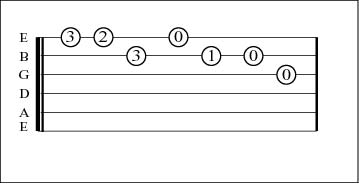 OK
here is a change of pace. If you had trouble with the last one, this should
be easier. I think the moves in this example are very interesting.
OK
here is a change of pace. If you had trouble with the last one, this should
be easier. I think the moves in this example are very interesting.
This type of move is something I use from time to time because I like the interplay of the high E and B strings.
Keep in mind these are mini leads. In a real improvisation, you may chain several of these together. We are trying to jump start the process here.
This next example uses the highest three strings and ends with two C notes (tonic). The blue notes can be played as a hammer on. You play a hammer on by striking the open string and then tapping the note. This allows the higher note to sound and since you are only tapping the note, when you release the note, the open string rings again. This is an easy example of slightly changing the order of notes to create a tasteful small phrase. This example uses only the first three strings of the C scale (except for the lower tonic). Only the notes of C major diatonic are used.

When I am just goofing around, I will play endless versions of short licks just like this. I usually look for new and interesting combinations.
Some of these combinations I will come back to time and time again. You can change the tempo or add a few additional notes or combine these notes with tricks like slurrs, hammer ons, mini barres, pull offs and other creative ways of altering the sound.
Now lets look at a scale that is higher up the fretboard.

 This is what I call the second position C major scale. We
are going to play a micro lead to get the feel of working up higher and
away from the open strings. Often times I will set up in a certain position
when using this pattern. I will often barre the E and A notes on the B
and high E strings at the fifth fret (yellow notes). Then the remaining
three fingers will take responsibility for one fret each.
This is what I call the second position C major scale. We
are going to play a micro lead to get the feel of working up higher and
away from the open strings. Often times I will set up in a certain position
when using this pattern. I will often barre the E and A notes on the B
and high E strings at the fifth fret (yellow notes). Then the remaining
three fingers will take responsibility for one fret each.
Here is the tablature for this microlead.
The blue notes can be played as a hammer on and the E and A notes can be barred.
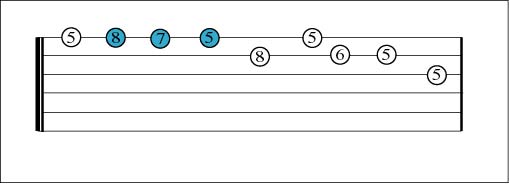
This is of course only one example of small lead parts carved from the scale. The hard part is fitting the exact combination of notes to the chords someone else is playing. You should concentrate on developing your own pathways. Even when I play these back, they can sound canned sometimes. If you practice scales, then you should use these to get ideas and then go off and try it yourself. That is what you will do in The Need For Speed this month.
Here is one final example of a pattern to try.
This is the second position G major scale.

 One of my favorite guitarists, Steve Howe of Yes started
the song "Roundabout" with a lead carved out of this pattern.
He uses hammer ons and travels down to the C note on the A string. It
is a very powerful beginning.
One of my favorite guitarists, Steve Howe of Yes started
the song "Roundabout" with a lead carved out of this pattern.
He uses hammer ons and travels down to the C note on the A string. It
is a very powerful beginning.
While you are at it, you can tie this into improvisation. You can always try playing leads over the song (if you have the CD) and try to fit some passages over it. Use this pattern and try to create some interesting passages right over Howe's work. He probably won't mind and it will give you a chance to get in his head and experience the same decisions he may have contemplated.
This hopefully will point out how many unheard riffs and songs are locked away in just these notes. There are a million new riffs waiting for anyone who takes the time to develop some muscle coordination and play with combinations.
It is guaranteed that your leads will be different from mine even if we use the same palate of notes. There are just too many combinations available to use for construction.
The Need For Speed is going to be more of this same material. The only way to understand this is to engage your hands. Using these same patterns you will have the opportunity to carve out a few leads of your own.
One last point. When you are first experimenting with this material or trying to play leads, keep it simple! You are not interested in proving how good you are, you are trying to engage some simple processes. If someone is showing you how to do this and using advanced solos, it can be hard to reproduce the results or mimic the movements or even understand what is being played. At first play simple songs and form simple leads. Once the concepts are clear to you, then you can start to increase the level of difficulty.